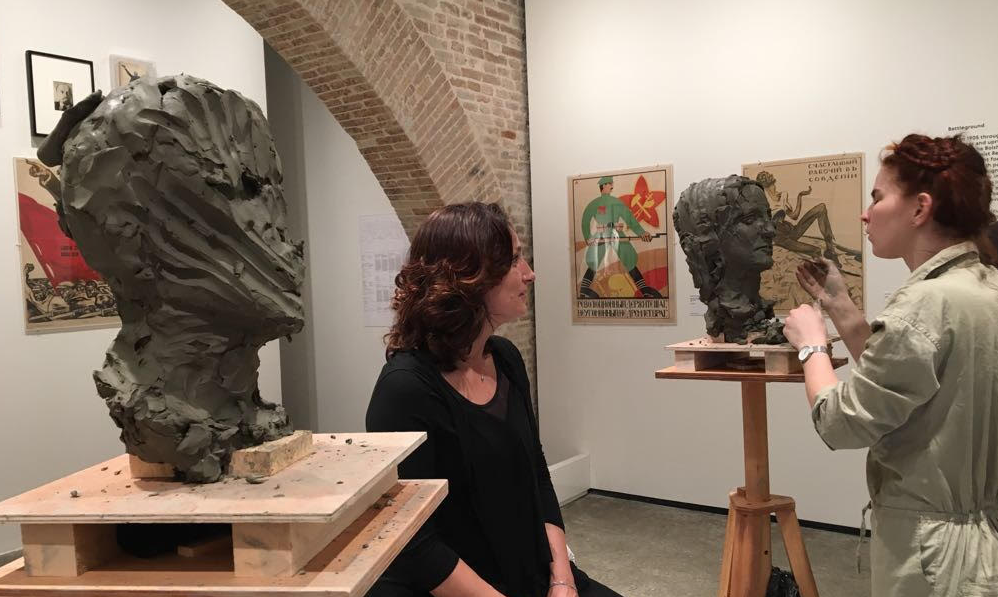10.05.2017 – 25.08.2017 /
V-A-C Foundation
Palazzo delle Zattere
Venice, Italy
Performance
Space Force Construction
V-A-C Foundation is proud to present Space Force Construction, organised with the Art Institute of Chicago, for the launch of V-A-C’s new Venetian headquarters.
Marking the centenary of the 1917 Russian Revolution, Space Force Construction considers the legacy of early Soviet art and its spaces of display. The exhibition brings together more than 100 works from the 1920s and ‘30s along with major reconstructions of spaces, sculptures and functional objects by key Soviet artists such as El Lissitzky, Gustav Klutsis, Aleksandr Rodchenko and Varvara Stepanova. These recreations and historical art works are brought into dialogue with new commissions and recent works by contemporary visual and performing artists, among them Abraham Cruzvillegas, Melvin Edwards, Janice Kerbel, Irina Korina, Barbara Kruger, Christian Nyampeta, Florian Pumhösl, Wolfgang Tillmans and Mikhail Tolmachev.
The exhibition revisits through contemporary eyes the international exchange of ideas opened up by early twentieth-century Russian artists, suggesting for their time and ours how we might reconceive spheres of public and private life to bring about social change.
Space Force Construction will organise the entire Palazzo delle Zattere into display spaces that were exemplary in the early Soviet period: battleground, factory, exhibition, school, home, theatre, press and festival.
An atrium on the ground level becomes a “Lenin Wall,” filled with original posters, book covers,drawings and photographs that feature the founding Soviet leader. Near this space is a rare early printing of the iconic poster Beat the Whites with the Red Wedge (1920) by El Lissitzky. A large room at the rear contains Rodchenko’s 10- meter-long Workers’ Club, first made and shown in Paris in 1925, which artist Christian Nyampeta will use during the opening days to hold discussions among philosophers and students in Venice. Further groups will be invited to self-publish and exhibit materials in an adjacent printing room that Nyampeta has helped organise.
Three rooms on the first floor will contain recreations of radical abstract sculptures exhibited in May 1921 at the second exhibition of OBMOKhU (Society of Young Artists), including Rodchenko, Vladimir and Georgii Stenberg, and Karl Ioganson. These dramatically simple forms paved the way for International Constructivism, a movement that swept Europe in the 1920s and ‘30s and was widely reinterpreted in Latin America, Eastern Europe and the United States during the 1950s-1970s. Works in the show by Abraham Cruzvillegas, Melvin Edwards, Janice Kerbel, David Musgrave, and Florian Pumhösl attest to the ongoing relevance of this Russian-born movement.
A new commission by Barbara Kruger will cover the floor and walls of a room on the second floor of the palazzo with an image of a hand holding out an iphone with apps that show declarative virtues and vices in Russian, English and Italian. Kruger will also place a text addressing mass media and demagoguery on the floor of the room, surrounding a prototype for a multimedia kiosk designed by Gustav Klutsis in 1922. The kiosk will contain books and magazines, and a period newsreel projection. Another room on this floor includes a barbed-wire sculpture from 1970 by Melvin Edwards, Wolfgang Tillmans’ 2015 photograph The State We’re In, and text-and- image elements from the series The Transported of KwaNdebele (1983- 1984) by South African photographer David Goldblatt. The three artists’ works raise issues of migratory labour – a contemporary theme that puts the heritage of Soviet constructivism and photojournalism to new and very different uses.
The exhibition features new works by emerging Russian artists including an installation by Kirill Glushchenko who explores the concept of the ‘ideal’ in Soviet Brezhnev–style modernity. At the core of his project is the history of a massive reconstruction of the city of Ulianovsk, its local memorial complex and hotel Venets, all built in 1970 to mark the centenary of the birth of Vladimir Lenin. Glushchenko will recreate the interior of the hotel lobby and room on the ground floor of the palazzo. The installation embodies a constellation of objects related to Soviet material culture and its utopian promise.
Mikhail Tolmachev’s project, SLON, is devoted to the lost story of the Solovki prison camp on the Solovetsky Islands, revealing a parallel existence of official and hidden Soviet history. Despite the common belief that a wide labour camp system in the Soviet state was an invention of the Stalinist era, Solovki prison camp was founded in 1920 and considered to be the first of its kind. Tolmachev explores the camp’s social and cultural structures through three official photo albums produced at the labour camp’s studio.
Space Force Construction is curated by Matthew Witkovsky, Richard and Ellen Sandor Chair and Curator of the Department of Photography, Art Institute of Chicago and V-A-C Curator Katerina Chuchalina, with Anna Ilchenko. Peter Taub is in charge of a performance programme that is integral to the exhibition. The Art Institute of Chicago has published a richly illustrated, scholarly catalogue to coincide with the Venice exhibition, devoted to art and its display in the early Soviet period. An entirely historical version of the joint undertaking, called Revoliutsiia! Demonstratsiia! Soviet Art Put to the Test, will be presented from 29 October 2017 – 14 January 2018 at the Art Institute of Chicago. A major lender is the Ne boltai! Collection, who have enriched the exhibitions in Venice and Chicago with many key works relating to the early Soviet era.
